The newspapers were full of the newly introduced DMU service, between Shalimar and
Digha, touting it of Japanese design. Saurab and I decided to give it a try, so on April 30, he came over to my
place and we took a cab to Shalimar station. Our plan was to take the DMU which leaves at 1750 (on weekends only)
and arrive at Digha at 2205, spend the night either at the Retiring Room or at a Hotel and take a train back the
next day.
We went to the ticket counter near the level crossing at Shalimar but found out that the tickets for the DMU are
issued from the regular counter at the station, which is where we headed. We got two tickets (Rs 31 each for the
184 kms) and Saurab asked the clerk for a platform ticket. The clerk said he didn't need one, but when he heard
that Saurab wanted one for his collection, he gladly obliged. Since Shalimar doesn't have regular platform tickets,
a 'pink slip' book was duly filled in, and the carbon copy handed to Saurab.
From there we headed to the platform. There was an hour or so for us to kill, so we walked around. A couple of
WDS6s were the only companions. We chatted with the yard staff / RPF guys who were sitting beside the tracks and
even asked them if we could take pictures. They refused! It had started clouding up and with the drizzle starting
we headed to the platform for shelter. After the skies cleared somewhat we headed out again and towards the level
crossing saw the DMU approach. It looked dreamlike, compared to what we are used to. The majestic breaut (brute
+ beaut) glided past us and disappeared towards the station. We didn't have much time to take great photos, and
had to rush back to the platform.
The DMU was parked right in front of us. An unusual streamlined shape, with red, blue and white livery stood gleaming.
The large windows, for a change without bars, made for a splendid sight. There was a LED destination board just
behind the windscreen. The front was of fiberglass, which wasn't finished too perfectly, as evident from the painting.
Yet it looked dreamlike, and the crowds along the platform bore testimony to that. This model looks somewhat different
from the one at Bhimavaram, a more simplified version.
A press photographer, in various states of contortion, was shooting the DMU. We asked the RPF posted there since
the photographer was shooting, we should too, and he said 'let me go and then you can'. So we did, but by then
light wasn't so good because of the overcast sky, and the photo opportunities were the best. A lot of people were
crowding the platform, and it was almost time for the train to leave. We stepped into the spacious driving cab
and managed to get a few shots too.
The air-conditioned cab is very spacious and welcoming. The comfortable looking chairs can swing to create more
space. The driver's panel in front is uncluttered and neat, with a good ergonomic feel to it. The full size windscreen
affords a great view ahead. We had a look around before heading for a coach. Immediately behind the driving cab
was the ladies coach and then the vendors and we boarded the one next to it.
The coach was well spaced out, with comfortable cushioned seats in blue. There was fluorescent lighting and the
center panel had a PA system as well as provisioning for, what I assumed to be, future air-conditioning. It was
all stainless steel, giving a neat clean look. The maintenance wasn't perfect though, with a lot of dirt and dust
showing up. The horizontally divided windows were large and had two glass panes. The lower pane could be raised,
which gave a good enough view. There was a rectangular frame bolted to the window frame that had horizontal bars
running, for added protection. The worse was now to come. The lower windowpane can be latched to the frame. This
latch was of very bad finish, and rather dangerous. It was evident that this hastily done job didn't take into
account any design sensitivity. The parts were small and very sharp, and very capable of causing injury. The frame
around the window (not the pane) was of fiberglass, painted silver, instead of the regulation aluminium. The frame
was already cracking and chipping in many places, with the fibres exposed and visible.
While we were shooting the interiors of the coach at Shalimar station, we had one gentleman coming to us rather
agitated, asking us whether long distance trains were supposed to have toilets. I told him yes, if a train ran
for 150 kms and above, toilets were a necessaity. He was rather livid, since this DMU had none, and kept saying
that he had complained about the fact to the GM/DRM who had empathised with him. It seemed the empathy hadn't helped.
He went on and on, and when I told him we were not from the press, he openly stated we were trying to make a fool
of him, since it was obvious (from the way we were shooting trains) that we were indeed press folks. We went as
far as to state, that ordinary people did not indulge in take photos of trans :) Incidentally, there seemed to
be enough space to add in toilets.
We started off at 1750. Started off with a jerk, which we thought was because the drivers were probably not used
to the controls as yet. All the starts were jerky, but after that, the motion smooth. The first stop was Santragachhi
Jn, and then we would run non-stop till Mecheda, after which it would stop at all stations till we reached Digha.
At Santragachhi, a sizable lot of local passengers boarded, quickly filling up the coach. We trundled on till we
reached Mecheda, where suddenly, almost in unison Saurab and I looked at each other, wondering whether we should
just get off and make our way back. Since we had already checked out the DMU, it didn't make sense making the long
trip to Digha and look for accommodation in the middle of the night. So get off we did, after dithering a few moments.
The DMU hooted and started, and we watched till the rear lights, blinking slowly, passed off into the oblivion.
We then crossed over to the station entrance, got the return tickets and came back on the platform. Had a few minutes
to wait till the next local to Howrah came in, during which, the Howrah bound Falaknuma whizzed past, a WDM3a baldie
of VSKP at the lead.
The return journey was tiring. Though we did get seats, I was not keeping too well and I relaxed and dozed off,
listening to music. It took us from 1940 till about 2130 to get to Howrah, and luckily we made good time. And luckily
there were enough cabs at Howrah this time, with no queue at all. So getting home was breeze, well almost, if it
wasn't for the traffic jam on Howrah Bridge and beyond! |
|
|
|
|
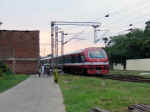
The DMU approached Shamilar Station.
|
|
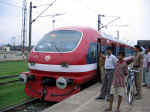
The DMU awaiting departure from Shalimar.
|
|
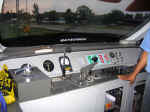
Inside the DMU's cab.
|
|
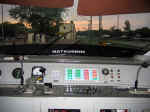
Another view from the DMU's cab. You can see the Shalimar cabin to the left.
|
|
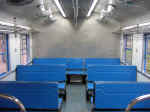
Inside the DMU's passenger area.
|
|
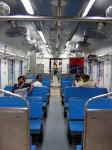
More of the passenger area. Note the lighting and the channel provided for future
air-conditioning.
|
|
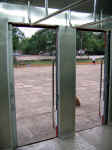
The double doors.
|
|
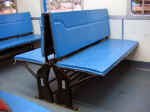
The cushioned seats in blue rexine upholstery.
|
|
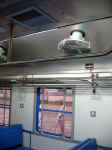
The large airy windows.
|
|
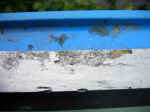
You can see the damaged edges of the fibreglass window frames.
|
|

